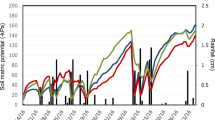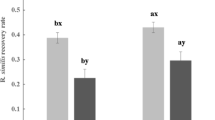Abstract
The long-term effectiveness of soil solarization integrated with (integration of pest management [IPM]) a biological control agent (Trichoderma virens), chemical fungicide (pentachloronitrobenzene [PCNB]), organic amendment (chicken litter) or physical method (black agriplastic mulch) to reduce southern blight (Sclerotium rolfsii) and southern root-knot diseases (Meloidogyne incognita) were evaluated on vegetable production. Results showed that the long-term effectiveness of IPM plus soil solarization reduced soilborne diseases of vegetables more than two years following the termination of solarization. These disease management strategies in 1991 and 1992, following soil solarization in 1990, reduced the numbers of sclerotia in the soil, and the number of plants killed by southern blight and root-knot of tomatoes, compared to nonsolarized bare soil treatment. The integration of a reduced dosage level of PCNB or T. virens in field plots, reduced southern blight of tomatoes by 100% and 71%, respectively, in solarized soil, compared to nonsolarized bare soil two years following soil solarization. PCNB effectively controlled southern blight in nonsolarized bare soil both years. All solarized treatments, except PCNB plus solarized soil increased tomato yields compared to nonsolarized bare soil plots. In the second study (1992) following soil solarization in 1991, the effectiveness of solarized bare soil, and nonsolarized bare soil mulched with black agriplastic film, with or without Reemay spunbounded polyester row cover, were effective in reducing root-knot of tomatoes as indicated by the root-knot gall index. Following a one year fallow period in 1994 three years following soil solarization, the root-knot gall index for severity of tomato roots grown in solarized bare soil, nonsolarized bare soil, black agriplastic mulched bare nonsolarized soil and black agriplastic mulched solarized bare soil, were 1.0, 3.0, 3.0 and 2.0, respectively, on a 0–5 scale, where 0=0% and 5=100% root-knot galled. In the third study 1992 and 1993, different dosage levels of chicken litter were used to amend soil artificially infested with sclerotia of S. rolfsii at different depths following solarization, decreased the number of viable sclerotia by 85–100%. All solarized treatments and nonsolarized bare soil amended with 18.8 MT/ha of chicken litter, were effective in controlling southern root-knot damage, and postharvest storage root rots of sweetpotato storage roots (Fusarium root rot [Fusarium solani] and Java black rot [Diplodia tubericola]). Our study showed that all soil solarization treatments, and soils amended with chicken litter, stimulated a shift in the soil microbial population dynamics. Rhizobacteria of Bacillus spp. and fluorescent pseudomonads increased significantly in the rhizosphere, rhizoplane, and interior root tissues of tomatoes and sweetpoatoes, grown in solarized soil compared to nonsolarized soil. These microorganisms may have contributed to the increased growth response of vegetables and some were probably suppressive to soilborne diseases
Similar content being viewed by others
References
Adams J, Rodriguez-Kabana R and King P S 1979 The non-target effects pentachloronitrobenzene on plant parasitic and free-living nematodes [Effectos aleatiruis de pentacloronitrobenceno sobre nematodes fitoparasitos y de vida libre]. Nematropica 9, 110–112.
Aharonson N and Jaacov Katan 1991 Pesticide behavior in solarized and disinfested soils. In Soil Solarization. Eds. J. Katan and J DeVay. pp. 132–138. CRC Press, Boca Raton, FL.
Aycock R 1966 Stem rot and other diseases caused by Sclerotium rolfsii or the status of rolfsii fungus after 70 years Tech. Bul. No. 174, North Carolina Agricultural Experiment Station. 202 pp.
Brown J E, Stevens C, Osborn M C and Bryce H M 1989 Black plastic mulch and row cover as method of southern blight control in bell pepper. Plant Disease 73, 931–932.
Clark C A and Moyer J W 1988 Compendium of Sweet Potato Diseases. APS Press The American Phytopathological Society St. Paul, MN. 74 p.
Collins D J, Stevens C and Khan V A 1993 Effects of soil solarization on southern blight of lupins. Phytopathology 83, 465 (Abstract).
Davis J R 1991 Soil solarization: Pathogen and disease control and increased in crop yield and quality: short-and long-term effects and integrated control. In Soil Solarization. Eds. J Katan and J De Vay. pp. 40–50. CRC Press, Boca Raton, FL.
Dhingra O D and Sinclair J B 1986 Basic Plant Pathology Methods. CRC Press, Inc., Boca Raton, FL. 355 pp.
Elad Y, Katan J and Chet I 1980 Physical, biological and chemical control integrated for soilborne diseases in potatoes. Phytopathology 70, 418–422.
Gamliel A and Katan J 1991 Involvement of fluorescent pseudomonads and other microorganisms in increased growth response of plants in solarized soil. Phytopathology 81, 494–502.
Gamliel A and Stapleton J J 1993a Effect of chicken compost or ammonium phosphate and solarization on pathogen control, rhizosphere microorganisms, and lettuce growth. Plant Disease. 77, 886–891.
Gamliel A and Stapleton J J 1993b Characterization of antifungal volatile compounds evolved from solarized soil amended with cabbage residues. Phytopathology 83, 899–905.
Garibaldi A and Gullino M L 1991 Use of solarization in marginally suitable climates. In Proceedings of the First International Conference on Soil Solarization. Eds. DeVay J E, Stapleton J J and Elmore C L. pp. 253–265. Amman, Jordan 1990, Rome FAO Paper, 109.
Griffin J and Baker R 1991 Population dynamics of plant pathogens and associated organisms in the soil in relation to infectious inoculum. In Soil Solarization. Eds. J Katan and J DeVay. pp. 3–21. CRC Press, Boca Raton, FL.
Grinstein A, Katan J, Abdul-Razik A, Zeidan O and Elad Y 1979 Control of Sclerotium rolfsii and weeds in peanuts by solar heating of soil. Plant Disease Rep. 63, 1056–1059.
Grinstein A and Ausher R 1991 Soil solarization in Israel. In Soil Solarization. Eds. J Katan and J DeVay. pp. 193–204. CRC Press, Boca Raton, FL.
Grinstein A, Kritzman A, Hetzeroni A, Gamliel A, Mor M and Katan J 1995 The border effect of soil solarization. Crop Protection 14, 315–320.
Jenkins F and Averre C W1986 Problems and progress in integrated control of southern blight of vegetables. Plant Disease 70, 614–619.
Jones J B, Stall, R E, and Zitter T A 1991 Compendium of Tomato Diseases. APS Press, The American Phytopathological Society. St Paul MN. 73 p.
Katan J 1981 Solar heating (solariztion) of soil for control of soilborne pests Annu. Rev. Phytopathology 19, 211–236.
Katan J 1998 Soil solarization: Integrated control aspect. In Principles and Practice of Managing Soilborne Plant Pathogens. Ed. R Hall. pp. 250–278. APS Press, St. Paul, MN.
Khan V A, Stevens C, Wilson M A, Brown J E, Collins D J, Lu J Y and Rhoden E G 2000 Evidence of rhizobacteria changes associated with the increased growth response of vegetables grown in agrimulch systems. J. Veg. Crop Production 6, 53–73.
Mihail J D and Alcorn S M 1984 Effects of soil solarization on Macrophomina phaseolina and Sclerotium rolfsii. Plant Disease 68, 156–159.
National Research Council Board of Agriculture 1987 Regulating Pesticides in Foods-The Delaney Paradox. Board of Agriculture. National Research Council, National Academy Press, Washington DC.
National Research Council Board of Agriculture 1993 Pesticides in the diets of infants and children. Board of Agriculture National Research Council, Washington, DC, National Academy Press, Washington DC.
Overman A J 1985 Off season land management, soil solarization and fumigation for tomato. Proc. Soil Crop Sci. Soc. Fld. 44, 35–39.
Ristaino J B, Perry K B and Lumsden R D 1991 Effect of solarization and Gliocladium virens on sclerotia of Sclerotium rolfsii, soil microbiota, and disease incidence on tomato. Phytopathology 81, 1117–1124.
Rodriguez-Kabana R 1986 Organic and inorganic nitrogen amendments to soil as nematode suppressants. J Nematology 18, 129–135.
Rodriguez-Kabana R, Beute M K and Backman P A 1980 A method for estimating numbers of viable sclerotia of Sclerotim rolfisii in soil. Phytopathology 70, 917–919.
SAS Institute 1995 “JMP Statistics and Graphic Guide, Version 3.1”. SAS Inc., Cary, N. C.
Stapleton J J and Devay J E 1982 Effect of soil solarization on populations of selected soilborne microorganisms and growth of deciduous fruit tree seedlings. Phytopathology 72, 323–326.
Stapleton J J, DeVay J E and Lear B 1991 Simulated and field effects of ammonia-based fertilizers and soil solarization on pathogen survival, soil fertility, and crop growth. In Proceedings of the First International Conference on Soil Solarization. Eds. DeVay J E, Stapleton J J and Elmore C L. pp. 331–336. Amman, Jordan 1990 Rome FAO Paper, 109.
Stevens C, Khan V A, Tang A Y and Wilson M A 1987 Evaluation of soil solarization for weed, root knot and insect control for sweetpotato. Proceedings of the Annual Southern Region American Society of Horticultural Science Meeting, February 1987. Nashville, TN.
Stevens C, Khan V A, Tang A Y, Bonsi C K and Wilson M A 1989 Long-term effect of soil solarization on controlling root-knot nematodes in vegetables. Proceedings of the Annual Phytopathological Society Meeting, August 1989.
Stevens C, Khan V A, Okoronkwo T, Tang A Y, Wilson M A, Lu J and Brown J E 1990a Soil solarization and Dacthal: Influence on weed, growth and root microflora of collards. HortScience 25, 1260–1262.
Stevens C, Khan V A, Wilson M A, Brown J E and Tang A Y 1990b Control of southern blight in bell peppers by soil solarization. National Agricultural Plastics Congress 22, 155–158.
Stevens C, Khan V A, Brown J E, Hochmuth G J, Splittstoesser W E and Granberry D M 1991 Plastic chemistry and technology as related to plasticulture and solar heating of soil. In Soil Solarization. Eds. J Katan and J DeVay. pp. 142–158. CRC Press, Boca Raton, FL.
Stevens C, Khan V A, Wilson M A, Brown J E and Collins D J 1999 Use of Thermofilm-IR single layer and double layer soil solarization to improve solar heating in a cloudy climate. Plasticulture 118, 20–34.
Author information
Authors and Affiliations
Corresponding author
Rights and permissions
About this article
Cite this article
Stevens, C., Khan, V.A., Rodriguez-Kabana, R. et al. Integration of soil solarization with chemical, biological and cultural control for the management of soilborne diseases of vegetables. Plant and Soil 253, 493–506 (2003). https://doi.org/10.1023/A:1024895131775
Issue Date:
DOI: https://doi.org/10.1023/A:1024895131775




